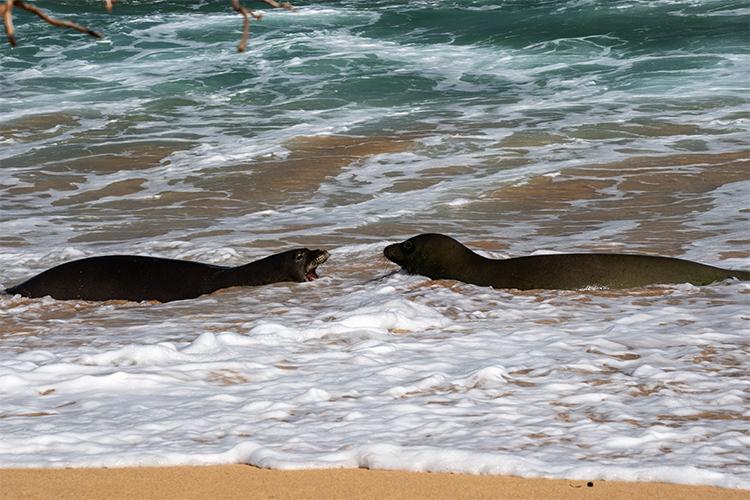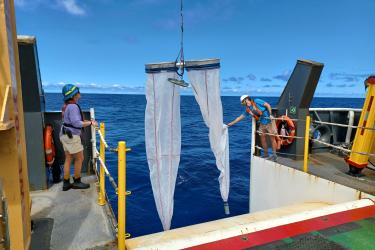We arrive at the remote shoreline, a 500-foot stretch of beach along the southern shore of Kauaʻi. It is a sight to behold. Four Hawaiian monk seals lie spaced out on the beach, while a handful of sea turtles bask in the distance. Wait, a couple of those turtles are oddly shaped—check that, there are six seals on this beach!
“This is an unusual sight in the main Hawaiian Islands,” commented Jamie Thomton, Kauaʻi Marine Mammal Response Coordinator with the NOAA Fisheries Pacific Islands Regional Office. Thomton and Mimi Olry, his Hawaiʻi Department of Land and Natural Resources co-coordinator, are conducting routine seal monitoring on Kauaʻi beaches.
Thomton instructs that we move slowly and quietly as we navigate around the seals, staying out of sight when possible. He photographs the seals from multiple angles and tries to get shots of their flipper identification tags.
We make it to the two turtle-seals at the end of the beach. As we watch from a distance, one of the seals, the smaller male, eventually awakens and flops towards the water.
This activity causes the larger seal, RG58, to stir from his slumber. RG58 was born in 2015 to the famed RH58 (“Rocky”), who recently gave birth to Koalani in Waikīkī. RG58 chases after the other seal and the two meet up at the water’s edge.
RG58 wastes no time squaring off against his beach rival. They let out guttural vocalizations and try to bite and body slam each other. But the battle ends as quickly as it began. The smaller seal rolls over into a submissive position and then swims off. RG58 moves back onto the sand near a female seal.
This isn’t the only time RG58 has been caught red-flippered behaving this way. “He has been cruising around Kauaʻi beaches,” Olry said.
So what gives? Is RG58 trying to become king of Kaua’i? Is he just a bad apple?
Actually, RG58 is likely just being an adult male monk seal, explained Thea Johanos, monk seal marine biologist with the NOAA Pacific Islands Fisheries Science Center. RG58’s “cruising” behavior and scuffles with other seals probably have to do with mating and establishing dominance.
In temperate regions around the globe, which have clearly defined seasons, the females of a species often all become ready to mate at around the same time of year. But monk seals in the warm, subtropical climate of Hawaiʻi can breed all year round. The timing in which individual females become ready to mate is spread out throughout the year.
Male Hawaiian monk seals do not defend territories, nor do they try to establish reproductive rights for multiple females. Rather, they’ll pair up with a single receptive female at a time and defend her against challenging males. Though males bite and body slam each other during fights for a female, these battles don’t usually result in any serious injuries.
An adult male seal looking for a mate will “cruise” coastlines for sexually receptive females. If a beach has a male-female pair of seals already on it, “the cruising male may approach the wave wash or wet sand and then roll back into the water,” Johanos said. In these cases the paired male will not be challenged. “But sometimes they’ll have a joust and fight it out, and the paired male will either be displaced or not.”
Males do appear to recognize each other and establish dominance hierarchies. “Two males who know each other well may often posture, but seldom make physical contact,” Thomton explained. “We assume it's because they have established dominance. However, if a new male rolls in, there is often a lot of physical contact.”
A dominant male who won a battle is not likely to be challenged by the losing male again. In fact, the most successful males—the ones who most often mate with females—are usually not challenged. And this social structure may begin to take shape when males are 3- to 4-year-old subadults. They’ll practice by defending pups and juveniles (1- to 2-year-olds) from other subadults, and work their way up the ladder.
“And then there is a subset of animals that never appear to be successful with females,” Johanos said. “Some males you never see cruising or paired with females. They may have just given up competing for females.”
It’s difficult to say what, exactly, caused RG58 to rush at the other seal on the beach. It could be the case that RG58, after cruising Kauaʻi beaches, has found a female to defend. He may have interpreted the other seal’s movement as a challenge or attempt to steal his mate.
Or perhaps something else entirely is going on.
“These are wild animals and a lot of activity happens when we’re not there,” Johanos said. “Almost all we know about their behavior is based upon what we see on the beach.”












